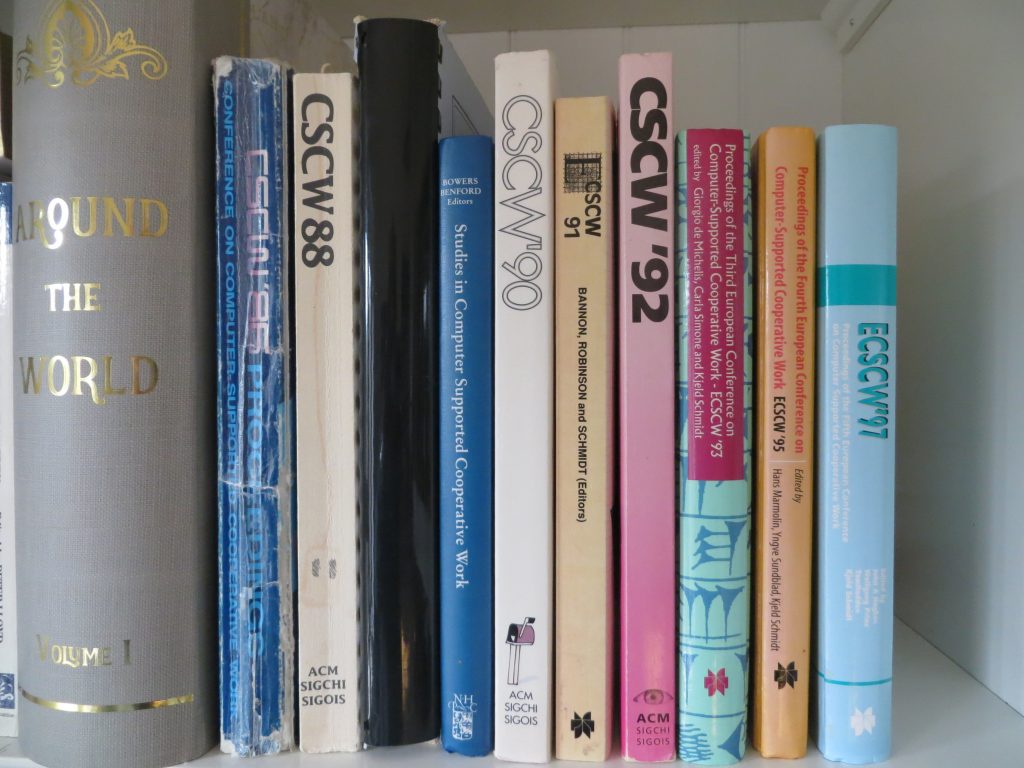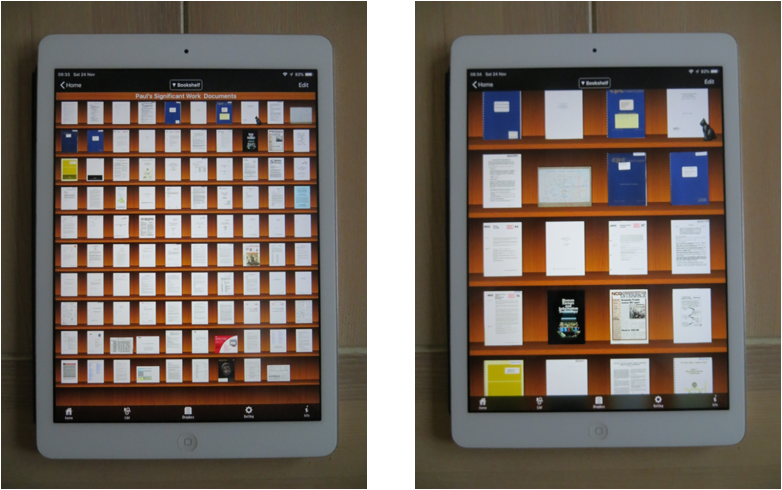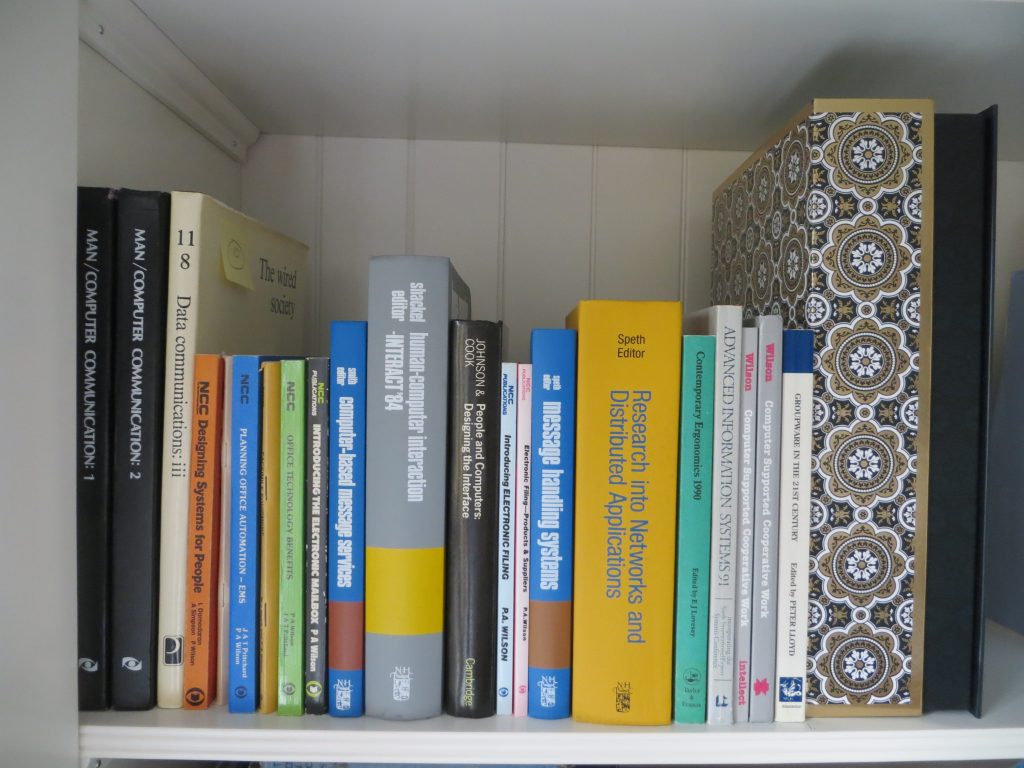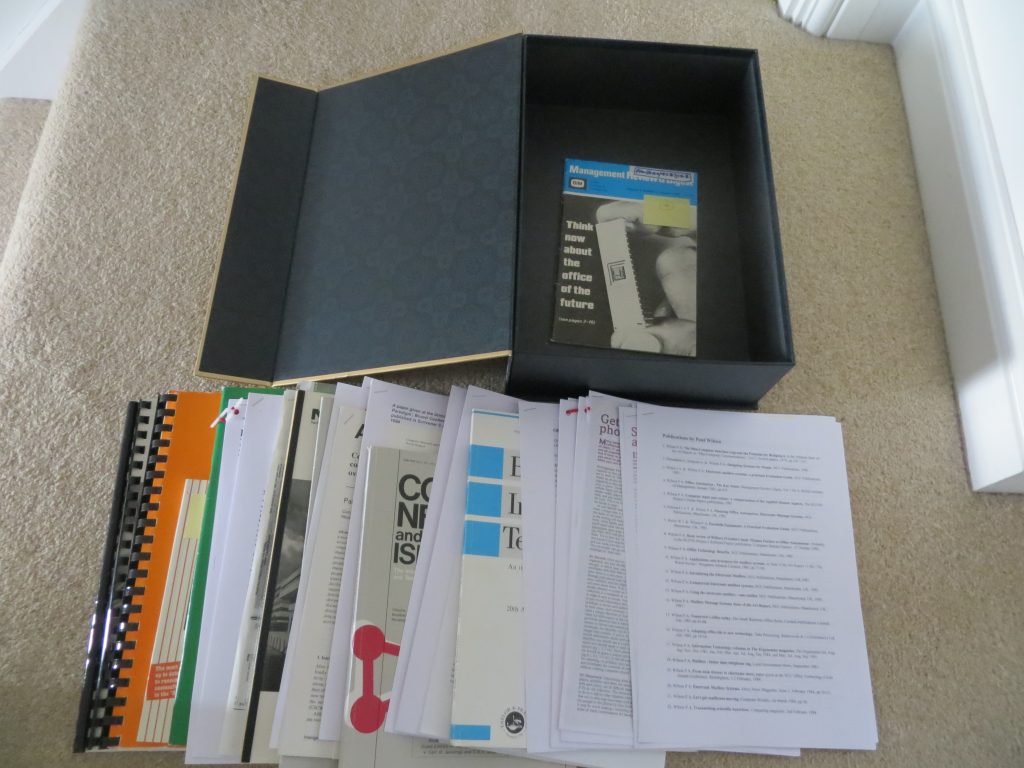The sort-out of my publications, reports and CSCW proceedings (broadly categorised as ‘things I had created and done’) confirmed that I have a particular interest in material I had created or had made significant contributions towards. It was undoubtedly rewarding to revisit the material – though I wouldn’t anticipate doing it again very often. In fact, it made me realise that just having the knowledge that all the material is available and easily accessible, is itself a very satisfying and reassuring thought. Of course, having a complete collection of work documents to draw on when assembling full sets of my publications and reports, was slightly unusual; most people might only have partial sets depending on what particular material they had saved in the course of their careers.
The items included in the category ‘things I had created and done’ are only a subset of all the work items I’ve kept over the years. I have previously digitised over 80 of my work book collection as described in the Electronic Bookshelf journey; I’ve created story boards for 30+ work books that I regarded as special in some or other; and my PAW-PERS collection of memorabilia contains aver 120 other items in the following additional categories:
Formal job documents (offer letters, job specs, pension info, pay slips etc.): I originally kept these for reference; but now, of course they have become very informative pieces of memorabilia.
Company information (brochures, newsletters etc.): Many of these are well presented documents providing detailed information about the organisations I worked for.
Recognition objects (certificates, long term service awards, contract win artefacts etc.): I didn’t keep the originals of certificates confirming I had completed in-company courses as they didn’t seem very significant; however I do value a certificate from my professional body and keep it framed on my study wall. I’ve kept the cut glass paperweight celebrating a contract win, and the cut glass bowl for long service, which are both in our crystal cabinet; though they are retained more because of their looks than as reminders of work. I also value the long service domino set (very nice in a large wooden box) which I chose deliberately because I knew I would want to keep it long term for both its utility and its looks.
People I worked with (humorous documents, social gatherings, leaving cards, etc.): These are generally mementos of the people I worked with and the activities we did together.
Associated activities (company sports and social clubs, trade unions, professional bodies etc.) These are mementos of my activities in organisations associated with my work, and they are surprisingly prominent in my collection. I guess they such organisations have played a significant part in my working life over the years.
In thinking back about what I’ve done with all these different sets of work items, I was reminded of how sometimes particular items have corrected a fact that I had mis-remembered. For example, for several years, I believed that I was the instigator of the Alvey project I was involved in (Cosmos). However, in trawling through my documents to create one of the Electronic Story Boards, I discovered that it was a colleague who had been the instigator and I was a very ardent subsequent advocate. I guess that often we remember things in the way we would like them to be, not necessarily the way they actually were. Hence, having some documentation or other artefact can cast a truer light on the past. However, it must be remembered that the documents we have may only be a subset of all the relevant documents that were produced; and/or that their contents may just be reflecting the biases of the authors. Hence, whatever the nature of our ‘record’, be it memory, or a selection of the relevant items that you have, or all of the items that you have, or, indeed, all the relevant items that exist in the world, we should always remember that it may not be the whole story.
As with my non-work mementos, most of these work items have been digitised and the originals disposed of; though a small number, which I decided are special in some way or other, have been retained in physical form. In this respect, these work items are very similar to other types of memento. However, there is one very significant difference: many of these work items will not be recognisable by my wife and family. That’s because my work took me to a different place and a different life for a part of each day – as it does for very many people; hence, work mementos are likely to mean more to the individual than to family, relatives and friends. Consequently, I suspect that such collections are even less likely than other types of mementos to be retained and maintained by future generations of the family. I believe this to be almost certainly true for physical work mementos (I can’t see people hanging onto bulky books and papers which mean little to them). However, I’m less sure about digital collections which, in principle, are much less obtrusive and much easier to keep in the short term, but do rely on some care and attention as computers are replaced and technology advances. In fact, this uncertainty must apply to all informally-held digital collections – too little time has passed so far to be able to discern if such material is being passed down the generations. Interestingly, I do see the possibility of Artificial Intelligence playing a role in managing such material, and this could significantly affect how much of its digital history a family may have access to in the future.
In summary, this short review of my work mementos seems to have thrown up the following insights:
- Categories of work mementos include; things the individual has created and done, work books, formal job documents, company information, recognition objects, people the individual has worked with, and associated activities.
- While work mementos are similar to other type of mementos, they do provide reminders of a part of life that is often very personal to the individual and often separate from family life. In as much as work is often done with other people, it is almost like a parallel life with a separate family; hence, it generates a separate set of mementos.
- Work concerns making, creating and doing things; and if individuals are in any way proud of what they have done, then they may well be keen to retain examples of what they achieved and to inspect them from time to time.
- It is very satisfying and reassuring to know that examples of what you have produced at work, are safely stored away and accessible when you want them. Just being able to have those thoughts may be as rewarding as actually looking at the material.
- Our ‘record’ of events is only as good as the material we have, be it memory or a few relevant artefacts, or lots of artefacts. We should always remain open to the possibility we don’t have all the facts.
- Work mementos are probably less likely to be passed on down family lines than other types of mementos.
- Physical work mementos are less likely to be passed on down family lines than digital work mementos.
- Artificial intelligence may result in many more digital mementos of all types being passed on reliably down the generations.





